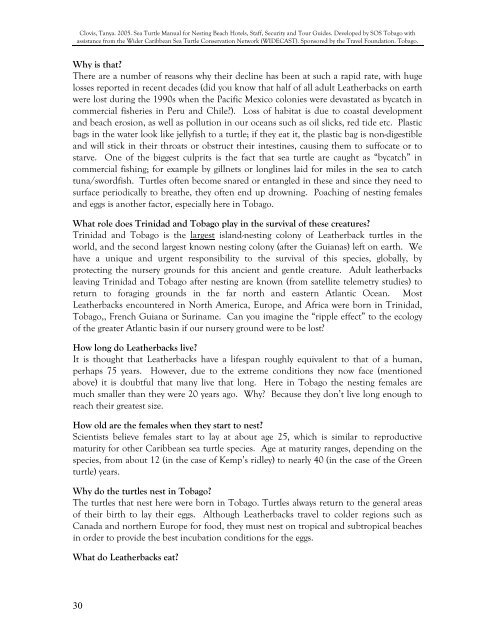Clovis, Tanya. - WIDECAST
Clovis, Tanya. - WIDECAST
Clovis, Tanya. - WIDECAST
You also want an ePaper? Increase the reach of your titles
YUMPU automatically turns print PDFs into web optimized ePapers that Google loves.
<strong>Clovis</strong>, <strong>Tanya</strong>. 2005. Sea Turtle Manual for Nesting Beach Hotels, Staff, Security and Tour Guides. Developed by SOS Tobago with<br />
assistance from the Wider Caribbean Sea Turtle Conservation Network (<strong>WIDECAST</strong>). Sponsored by the Travel Foundation. Tobago.<br />
Why is that<br />
There are a number of reasons why their decline has been at such a rapid rate, with huge<br />
losses reported in recent decades (did you know that half of all adult Leatherbacks on earth<br />
were lost during the 1990s when the Pacific Mexico colonies were devastated as bycatch in<br />
commercial fisheries in Peru and Chile). Loss of habitat is due to coastal development<br />
and beach erosion, as well as pollution in our oceans such as oil slicks, red tide etc. Plastic<br />
bags in the water look like jellyfish to a turtle; if they eat it, the plastic bag is non-digestible<br />
and will stick in their throats or obstruct their intestines, causing them to suffocate or to<br />
starve. One of the biggest culprits is the fact that sea turtle are caught as “bycatch” in<br />
commercial fishing; for example by gillnets or longlines laid for miles in the sea to catch<br />
tuna/swordfish. Turtles often become snared or entangled in these and since they need to<br />
surface periodically to breathe, they often end up drowning. Poaching of nesting females<br />
and eggs is another factor, especially here in Tobago.<br />
What role does Trinidad and Tobago play in the survival of these creatures<br />
Trinidad and Tobago is the largest island-nesting colony of Leatherback turtles in the<br />
world, and the second largest known nesting colony (after the Guianas) left on earth. We<br />
have a unique and urgent responsibility to the survival of this species, globally, by<br />
protecting the nursery grounds for this ancient and gentle creature. Adult leatherbacks<br />
leaving Trinidad and Tobago after nesting are known (from satellite telemetry studies) to<br />
return to foraging grounds in the far north and eastern Atlantic Ocean. Most<br />
Leatherbacks encountered in North America, Europe, and Africa were born in Trinidad,<br />
Tobago,, French Guiana or Suriname. Can you imagine the “ripple effect” to the ecology<br />
of the greater Atlantic basin if our nursery ground were to be lost<br />
How long do Leatherbacks live<br />
It is thought that Leatherbacks have a lifespan roughly equivalent to that of a human,<br />
perhaps 75 years. However, due to the extreme conditions they now face (mentioned<br />
above) it is doubtful that many live that long. Here in Tobago the nesting females are<br />
much smaller than they were 20 years ago. Why Because they don’t live long enough to<br />
reach their greatest size.<br />
How old are the females when they start to nest<br />
Scientists believe females start to lay at about age 25, which is similar to reproductive<br />
maturity for other Caribbean sea turtle species. Age at maturity ranges, depending on the<br />
species, from about 12 (in the case of Kemp’s ridley) to nearly 40 (in the case of the Green<br />
turtle) years.<br />
Why do the turtles nest in Tobago<br />
The turtles that nest here were born in Tobago. Turtles always return to the general areas<br />
of their birth to lay their eggs. Although Leatherbacks travel to colder regions such as<br />
Canada and northern Europe for food, they must nest on tropical and subtropical beaches<br />
in order to provide the best incubation conditions for the eggs.<br />
What do Leatherbacks eat<br />
30
















